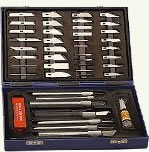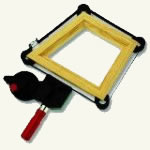- Repairing Kitchen Cabinet Damage
As previously mentioned the kitchen cabinets are located in a hostile environment and because of that, damage may occur. It is important that any damage to the kitchen cabinets be repaired as soon as possible as a damaged spot will tend to deteriorate quickly.
- Broken or loose wood joints can usually be repaired with a quality yellow carpenters glue and some furniture clamps
- It is not uncommon to have the wood veneer on the edges of door panels or frameless cabinets to peel back at the top or bottom.
Note: Always use plastic clamping blocks or scrap pieces of wood between the clamp jaws and the item being clamped to avoid jaw clam marks in the finished wood surfaces.

Figure 6 - Wood carving set

Figure 7 - Web clamp
- If you have a wood kitchen cabinet frame and one of the wood members as split or has broken you can attempt a repair in the following manner.
Remove the old glue from the veneer and the panel, usually there will be pieces of the underlying panel still glued to the veneer. To remove the glue carefully use a razor blade knife (an inexpensive wood carving kit is an excellent set of knives for kitchen cabinet repairs, see Figure 6) and some sandpaper to clean the veneer as best as possible.
Apply a thin coat of carpenters glue to either the veneer or the panel. Press the veneer against the panel edge. Some glue will be squeezed out of the joint, wipe it off using a damp cloth (do not use paper towel). Use a web clamp (Figure 7) to secure the the pieces together. Allow at least 24 hours for the glue to dry before removing the web clamp.
Note: Some kitchen cabinet repair instructions may suggest the use of tape to hold the parts together. In my personal experience tape does not provide enough tension to do a proper job, leaves a residue on the cabinet material and in some cases ends up being glued to the pieces.
Note: After attaching and tightening the web clamp make sure that any additional glue that may have squeezed out is wiped off.
Split wood - Before inserting any glue into the split, clamp the piece of wood to see if it will go back into its original form. In many cases it will be necessary to clean damaged fibers within the split in order to have the wood retain its original shape. The use of the knives in the wood carvers set, previously mentioned work well for this exercise.

Figure 8 - Glue injector
- Door hinge screw replacement
Once the joint will go back to its original shape, insert carpenters glue into the split wood. I suggest the use of an inexpensive glue injector, as shown in Figure 8. Wipe off any excess glue that is on the surface of the material.
Use an appropriate clamp to bring the wood together. If the situation will allow insert a wood screw (drill a pilot hole first) or drill a hole and insert a wood dowel through the damaged section to provide added strength.
Broken wood - If a piece of wood has actually separated from another piece (not at a joint), then you can attempt a repair by cleaning the wood fibers, where the pieces of wood join together, using the knives from the carving set, applying glue to one of the surfaces.
Always remember to wipe off any glue that squeezes out of the joint when clamped, with a damp cloth and allow the glue to dry for at least 24 hours prior to removing clamping mechanisms.
Loose screws in door hinges is a common problem over time. While many repair guides will tell you to remove the hinge and then fill the screw hole or holes with a combination of wood dust and glue or wood match sticks, this generally will not provide a lasting repair.
We have devoted two pages on hinge repair and replacement
